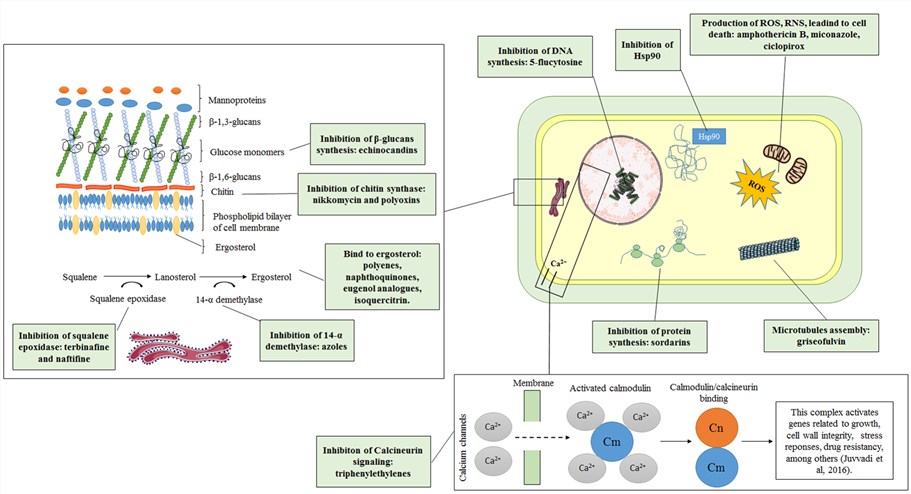Cell Membrane Targets
As a leading service provider in the field of biological research and drug discovery, Creative Biolabs is confident to provide a full range of antifungal drug discovery services, including target identification and validation, Hit identification, Hit to lead, Lead optimization, and IND enabling for customers around the world. Based on the professional team and advanced technology platforms, we have developed a complete protocol to identify and validate the potential targets related to fungal cell membrane.
Fungi Cell Membrane
Fungi and mammalian cells both contain a cell membrane that plays an important role in cell structure, division, and metabolism. Fungi cell membrane contains diverse lipids including the class glycerophospholipids, sphingolipids, and sterols. Glycerophospholipids are composed of glycerol-3-phosphate containing two fatty acyl chains along with various substituents like choline, serine, and ethanolamine. Sphingolipids contain a backbone of N-acylated phytosphingosine called ceramide. Sterols, also known as steroid alcohols, are amphipathic lipids that possess rigid and compact ring structures.
Although the structural components and functions are similar between fungal and mammal cell membrane, there are some specific-fungi components such as phospholipid synthase, types of sterols, and present in fungal cells but not in mammal cells. Hence, this difference in cell membrane components or key enzymes involved in cell membrane synthesis can be exploited as the target of antifungal drugs. Current antifungal drugs (e.g. polyenes, azoles, and allylamines) are used to treat superficial and invasive fungal infections via targeting ergosterol synthesis.
 Fig.1 Old and new targets as antifungal candidates.1
Fig.1 Old and new targets as antifungal candidates.1
Membrane phospholipid synthesis begins with the synthesis of phosphatidic acid from glycerol-3-phosphate by acyltransferase enzyme. In almost all de novo pathways, all membrane phospholipids are synthesized via common liponucleotide precursor called CDP-diaceylglycerol (CDP-DAG). In fungi, phosphatidylserine (PS) is synthesized by PS synthase through catalyzing the reaction between CDP-DAG and serine, whereas in other organisms phosphatidylethanolamine (PE) and serine are converted to PS by the enzyme PS synthase II. Therefore, targeting fungal PS synthase would be a promising approach for antifungal drug development.
Sphingolipids are the major components of the fungal cell membrane that exert diverse functions such as heat stress response, signal transduction, endocytosis, and apoptosis. Particularly, inositolphosphoryl ceramides (IPCs) play an important role in fungal pathogenesis and glucosylceramide (GlcCer). Studies have revealed that sphingolipids biosynthesis in fungi is structurally different than in mammals, thus fungal sphingolipids become a potential target for new antifungals.
It has been reported the steroid content in the cell membrane are different between mammals and fungi. Fungal cell membrane primarily contains ergosterol as the main component while mammal cell membrane mainly contains sterol. Thus inhibition of ergosterol biosynthesis has merged as the popular target for antifungal drug development. A kind of antifungals and allylamines suppress fungi cell membrane integrity via targeting squalene epoxidase (the key enzyme of ergosterol synthesis).
-
Lanosterol Biosynthesis
Although the lanosterol content in fungi cell membrane is lower than ergosterol, it is also required for maintaining integrity of the cell membrane. Lanosterol 14α-demethylase is a member of the cytochrome P450 superfamily that functions in lanosterol biosynthesis. It has been reported as an attractive target for antifungal therapy. The antifungal drug-azole targets lanosterol 14α-demethylase thereby suppressing fungal growth and survival.
P-ATPases are found in prokaryotes and a number of eukaryotic plasma membranes and they play an important role in the transport of ions and phospholipids across the membrane. Inhibition of P-ATPases biosynthesis specific to fungi is a promising target for antifungal therapy. Natamycin, an antifungal agent produced by Streptomyces natalensis causes suppression of growth of yeasts and fungi by inhibiting plasma membrane transport proteins which regulate amino acids and glucose transport.
Our Advantages in the Discovery of Antifungal Drug Targets
With years of experience in drug targets discovery, Creative Biolabs is fully competent and try to do better to help global clients identify their interested targets from the extensive repertoires of antifungal drug targets. We believe that our antifungal drug discovery package service certainly assists your antifungal drug discovery project.
- Experienced team of experts
- Advanced technology platform
- Extensive repertoires of pharmacological targets
- Rapid and accurate screening protocol
- Low cost and high services
If you are interested in our antifungal drug discovery package service, don’t hesitate to contact us for more details or a detailed quote.
Reference
- Scorzoni, L.; et al. Antifungal therapy: new advances in the understanding and treatment of mycosis. Frontiers in Microbiology. 2017, 8(74):36. Distributed under Open Access license CC BY 4.0, without modification.
For Research Use Only.
